|
|
5595 Last of the K(1353) class "Katies" |
|

The NSWGR once had a
fleet of 590 “Standard Goods” locomotives of the (D)50,
(D)53 and (D)55 classes.
5595 of the K(1353) / (D)55 class
now represents this fleet at Trainworks, Thirlmere, as seen in this photo dated
23 November 2008.
|
Builder |
Granville NSW |
|
Builder’s Number & Year |
334 of 1924 |
|
Wheel Arrangement |
2-8-0 |
|
No. in class |
120 |
|
The
K(1353) class 2-8-0 freight locomotives (reclassified as (D)55 in 1924) were
a further development of the earlier TF(939) / (D)53 design in the “Standard
Goods Locomotive” family started with the T(524) / (D)50 class in 1896. 120 examples of the (D)55
type were built by the Clyde Engineering Co Ltd at Granville between 1918 and
1925, bringing the total number of NSWGR Standard Goods Locomotives to
590. The K(1353) / (D)55 class
differed from the earlier TF(939) / (D)53 class principally by the use of
outside valves; the uncommon Southern
valve gear was chosen having been earlier tested on an aging Baldwin
2-8-0 freight locomotive, no 2904. The
K(1353) / (D)55 class were originally built with superheated tapered boilers
but were later fitted with a standard superheated parallel boiler which could
also be used with the earlier (D)50 and (D)53 types. The K(1353) class
engines were nicknamed “Katies” by NSWGR railwaymen. A
total of 70 (D)55 class members were converted to
oil burning in the years after World War 2, following industrial unrest which
threatened coal supples. (Apparently
the (D)55 class were best suited to oil conversion because
the outside valve gear provided more room for the oil burning gear to be
fitted to the firebox between the frames.)
However the oil fuel was more expensive than coal and hence most of
the oil burning engines were stored after the industrial unrest had
passed. 14 were subsequently converted
back to coal firing but the future for the rest was not positive with most
withdrawn in the 1950’s and quickly scrapped.
A number of the coal burning engines remained in traffic into the
1960’s. The last was 5597, withdrawn
July 1967 and scrapped on 21 August 1967, leaving 5595 as the only remaining example. Interestingly, significant numbers of the
earlier (D)50 and (D)53 engines still remained in
traffic at this stage. According
to “Steam Locomotive Data” (the bible for NSWGR steam locomotive
information), preserved engine 5595 entered service as K 1447 on 3 July 1924,
was withdrawn in July 1966 and condemned on 17 November 1967 with 1,658,884
km travelled, the highest distance for a (D)55 class engine. 5595 was stored at Enfield and had become
somewhat derelict when it joined the growing New South Wales Rail Transport
Museum (NSWRTM) collection in the Enfield No.1 Roundhouse, remaining in this
rust-streaked condition when transferred to the new NSWRTM site at Thirlmere
in 1974. 5595 was subsequently
repainted and restored for static display by NSWRTM volunteers during the
late 1990's and is now the sole representative of the 590 Standard Goods
Locomotives within the Trainworks museum at Thirlmere. It
is worth mentioning the various tender types used with Standard Goods
Locomotives. The K(1353)
class were originally fitted with “Wampu” bogie tenders of 4,000 gallons
water capacity, whereas the (D)50 class were supplied with 3,650 gallon bogie
tenders. Early (D)53
class members were also supplied with 3,650 gallon tenders but late build
(D)53 class came with Wampu tenders.
The K(1353) / (D)55 class conversions to oil firing were all based on
the Wampu tender type, with a riveted oil tank fitted into the coal space;
apparently the Wampu tender was best suited to this conversion. The NSWGR found that its fleet of
locomotive tenders was becoming life-expired by the early 1950’s, so
Commonwealth Engineering at Granville were contracted to build 201 new “Standard
Turret Tenders” of 5,000 gallons capacity for fitting to coal-fired Standard
Goods Locomotives. 5595 joined the
NSWRTM collection paired with the last surviving “Wampu” tender but in 1996
this was swapped with the Standard Turret Tender formerly paired with 5461; I
understand (from speaking with workshop staff at Thirlmere at the time) the
tender swap was done for operational reasons as there was some consideration
to 5595 being returned to service and the Turret Tender was younger and in
better condition. (In the webmaster’s
opinion, the original tender pairing better reflects the historical and
design considerations for both engines and hopefully the two tenders would
one day be swapped back, with the Wampu tender returned to Thirlmere for
display behind 5595.) A
spare (D)53 class boiler is also held in store by
the NSWRTM. As these boilers were
common to the (D)50 (superheated), (D)53 and (D)55
class locomotives, I imagine it could be used with 5595 if ever required. An
excellent resource for further reading on the TF(939)
/ (D)53-class is “Standards In Steam – The 53 & 55 Class” by Ron
Preston. Technical details for the K(1353) / (D)55-class locomotives can also be found on Wikipedia. |

A second view of 5595 (with 5910 alongside) at Thirlmere on
23 November 2008.
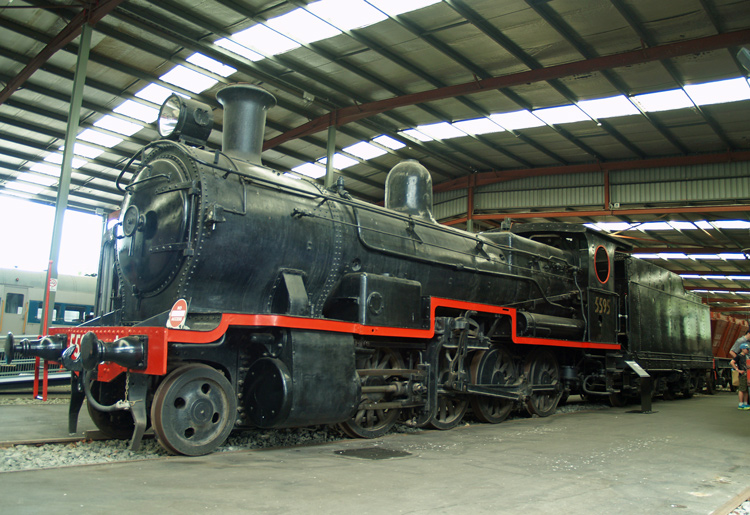
Left-side view of 5595.
2 March 2014.

A view of 5595’s Southern Valve Gear (right side), showing the
distinctive raised running board over the reverser. 23 November 2008.
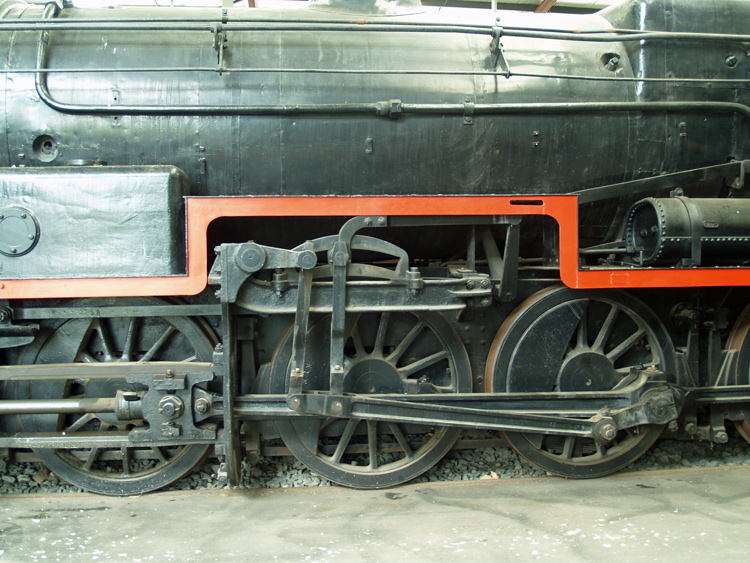
The Southern Valve Gear on the left side of the
locomotive. 2 March 2014.

Cab detail with the distinctive “Porthole” window. 23 November 2008.
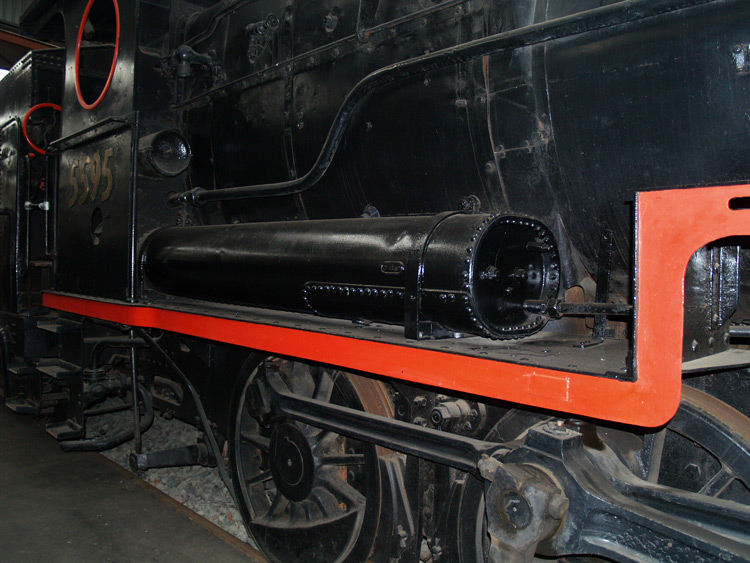
Detail of the riveted air receiver on 5595’s
footplate. 23 November 2008.
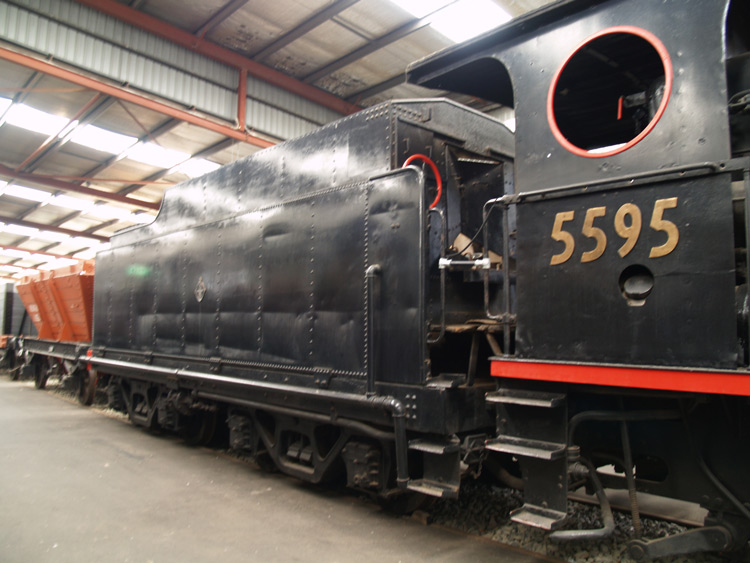
The Standard Turret
Tender formerly paired with 5461and displayed with 5595 since 1996.
The two deep gouges along the right side are clearly
evident!
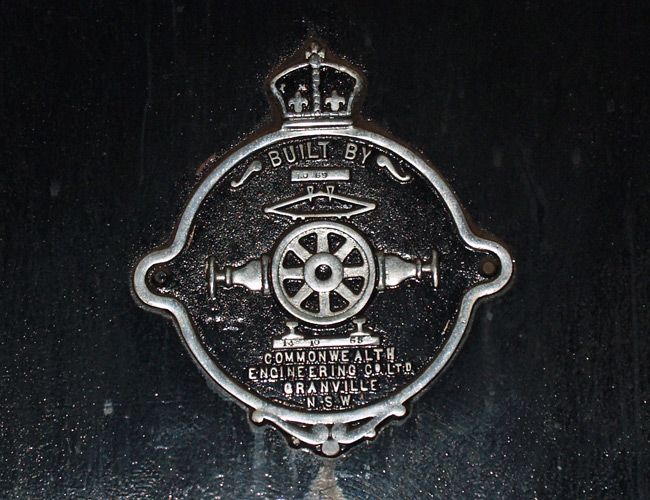
Builder's plate on the
Commonwealth Engineering Turret Tender formerly attached to 5461 (now paired
with 5595).
The plate is stamped with the builder’s number
"No.69" and the build date “13 10 53”.

A scanned photo view of 5461 at Thirlmere on 3 March 1996, paired with
the “Wampu” tender originally preserved with 5595.
While both (D)55 and some D(53)
engines operated with Wampu tenders, the type is perhaps better remembered
behind the D(55)’s such as 5595.
References
|
a |
“Standards
in Steam – the 53 & 55 Class” by R. G. Preston, Published
by Eveleigh Press, 2000. |
|
b |
"A
Compendium of New South Wales Steam Locomotives" compiled by Alex Grunbach, published by the Australian
Railway Historical Society, New South Wales Division, 1989. |
|
c |
‘Steam
Locomotive Data’ July 1974 edition, compiled by J. H. Forsyth for the Public
Transport Commission of NSW. |
|
d |
Webmaster's
observation or comment |
Page updated:
21 July 2015
|
Government Railways: |
|
|||||||||
|
Private & Industrial Railways: |
|